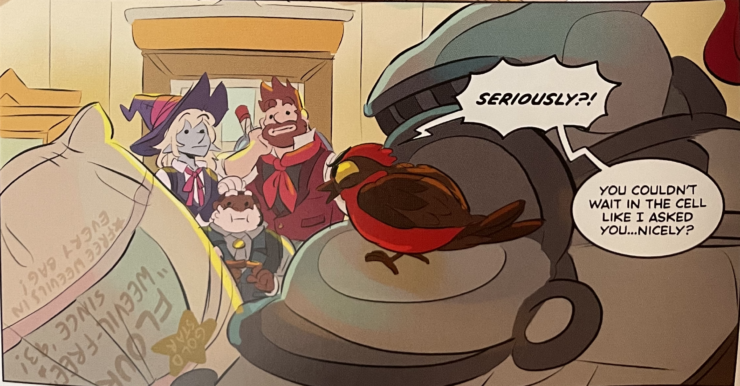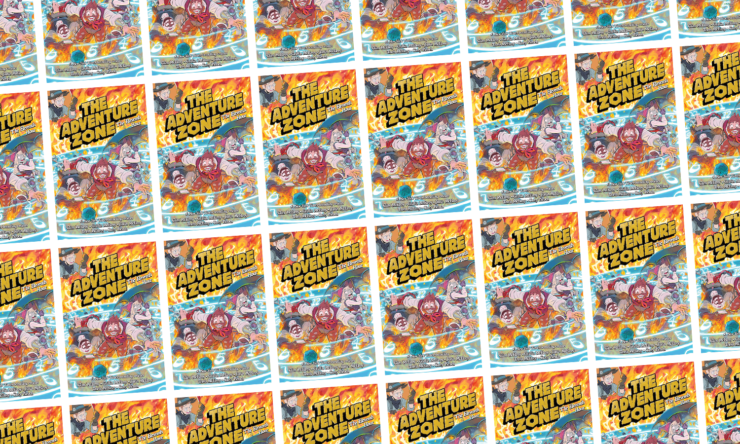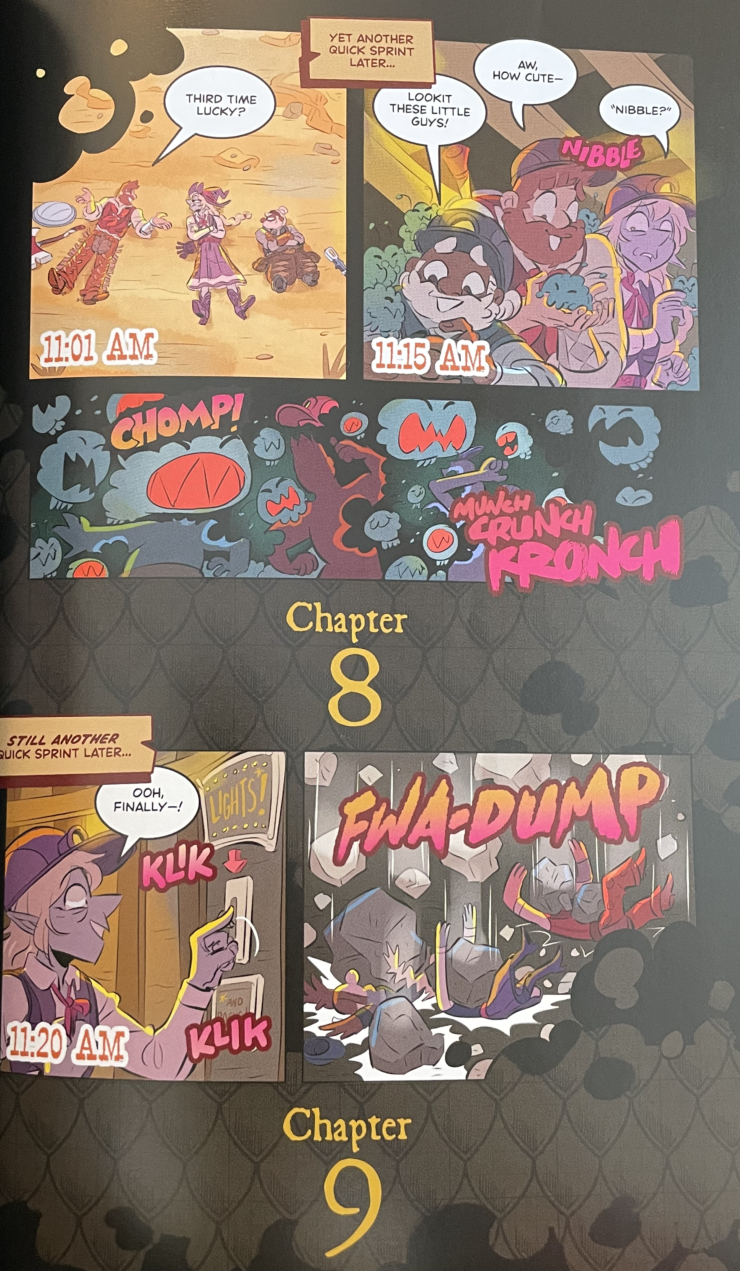Despite releasing (almost) annually since 2018, the fifth installment of The Adventure Zone graphic novel series still manages to surprise and delight. The plot hit our protagonists in full force with 2021’s Crystal Kingdom, and in this month’s Eleventh Hour, things only continue to get rougher and rowdier—this time with cowboy hats, time travel, and all the lovable NPCs a great DM could possibly muster.
Listeners of the TAZ podcast will already be familiar with the story beats of the McElroy’s time-bending arc: Taako, Magnus, and Merle are assigned to the small town of Refuge in their search for another dangerous Grand Relic. However Refuge isn’t like the other fantastical towns they’ve toured and/or destroyed—it’s trapped inside a mysterious bubble, forcing its inhabitants to relive the same hour on repeat, ending each time at noon in flaming, chaotic disaster. And so the gang trips from eleventh hour to eleventh hour, meeting and re-meeting the citizens of Refuge as they solve its mysteries, and dying new, grizzly deaths as they go.
Time travel is always a tricky thing to write, let alone adapt from audio to visual format. But artist Carey Pietsch and the McElroys have managed to use the graphic novel form to amazing ends, bending not only the narrative visuals but the layout features to show the passage (and corrosion) of time. Panels deteriorate or are tied together by threads of fate, and chapter title pages shrink and repeat and jump ahead—all coming together to make the reader’s experience just as wild and disorienting as the characters’. Seeing this story element come to life was, in a word, extremely cool.
The side characters of this arc are some of the best in the series, and Pietsch’s costume and character designs breathe new spirit and energy into them. Not only do we get the inhabitants of Refuge here, but also the various specters of the gang’s past: lost loves, ex-colleagues, abandoned children, and all. Julia, Magnus’ late wife, is drawn so beautifully, with the same brawny gentleness as her husband, that it broke my heart all over again to witness her. And Roswell (bird edition) made for the perfect straight man to the gang’s antics, with facial expressions that threw his armored companion’s stoicism into charming relief. Cassidy, local miner, redneck, and explosions expert, is the only one to have lost some dynamism in translation. Without Griffin’s voice to bring her strangeness to life, and without the gameplay mechanics to round out her interactions with the gang, her character falls a bit flat.
Cassidy’s characterization points to my main frustration with this volume overall: unlike the adaptations that preceded it, The Eleventh Hour feels rushed. The length of the story itself could have comfortably taken up two volumes instead of one, which makes sense for a mid-series entry that raises stakes and tension toward inevitable climax. But the pacing of individual pages suffers more than anything else, with more chaotic action sequences than previous volumes, and layouts much less bursting at the seams with detail, gags, and dialogue. I do think these changes reflect the realities of publishing deadlines far more than the talents of the artist—the design concepts remain great overall, like I discussed above, and there’s clearly so much heart put into each character interaction. However the rushed pacing does make for less emotional impact.

For instance, though we finally get backstories for our protagonists, and though the same information about them is conveyed, we spend far less time experiencing the flashbacks or witnessing the character/player reactions. Perhaps this is also a drawback of a more direct approach to adaptation—so much of what makes the characters in TAZ lovable is in the delivery by the players, rather than individual character beats working on their own terms. I may be in the minority among fans, but I’d rather see changes in an adaptation that make the story work in a new medium than receive the same beats without the voices and associations that lend them weight. It’s ironic too that, as DM Griffin’s hand in the storytelling becomes much stronger, his visual presence in the graphic novel all but disappears. How does one even approach adapting something like that?
The lack of emotional punch in this volume left the whole thing feeling lighter and lower-stakes than the original podcast, which isn’t necessarily a bad thing on its own—but it does make me wonder how much of a tonal shift the Suffering Game is going to be. Regardless, I’m along for the ride. Even if these graphic novels stand on their own less as they progress, they’re still beautiful—and funny!—artistic renderings of a story that I love, and I’m excited to see where they take me next.
The Adventure Zone: The Eleventh Hour is published by First Second.
Em Nordling is a writer & PhD student in Atlanta, GA.











